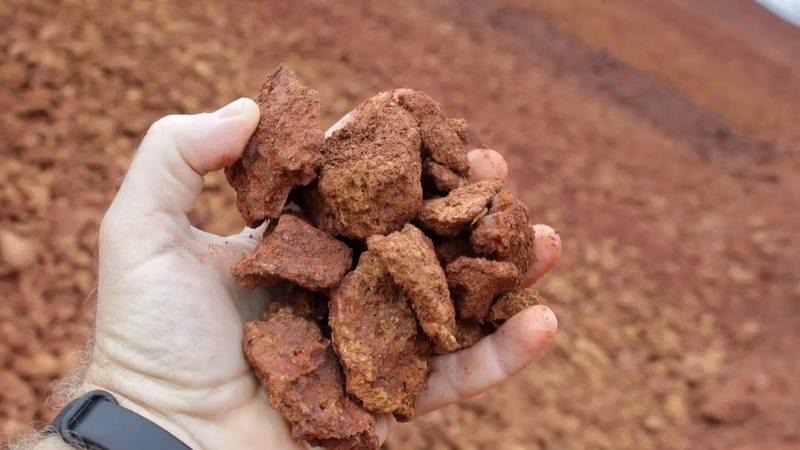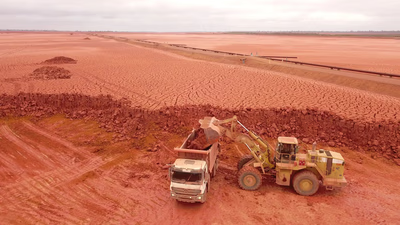
Bauxite transport methods in the Middle East"s trade network. "
Most countries in the Middle East supplement their needs by importing bauxite from other countries due to mining restrictions, variable quality of domestic mines, needs exceeding domestic production capacity, or other reasons. Bauxite ore is transported to the Middle East in different ways. Usually, the method of transporting bauxite to the Middle East depends on the distance, volume of cargo, costs and time required.
Bauxite is transported to the Middle East by sea from countries with bauxite mines to the destination. Bauxite is transported to the destination in the form of loading on large ships containing loads. Therefore, seaports in Middle East countries play an important role in importing bauxite. If the Middle East countries are close to bauxite producing countries such as Oman or Iran , ground transportation can also be used. Bauxite is transported to the destination by wagons, trucks and railways.
Türkiye is one of the largest importers and consumers of bauxite in the Middle East. The country has a strong aluminum industry and is dependent on imports to meet its bauxite needs, especially for aluminum production. Iran is also one of the countries that needs a lot of bauxite. Iran has a strong aluminum industry and depends on imports from other countries to meet its bauxite needs, especially for aluminum production.
Saudi Arabia is also known as one of the largest importers and consumers of bauxite in the Middle East. This country is dependent on imports from other countries to meet its bauxite needs, especially for the aluminum industry. Oman is also known as one of the countries that needs a lot of bauxite. This country is dependent on imports from other countries to meet its bauxite needs, especially for the aluminum industry.
Middle Eastern countries need bauxite because of its use in aluminum production. Bauxite is the main raw material for aluminum production and is used as a source of aluminum oxide in the aluminum production process. In the aluminum production process, bauxite is first converted into alumina. Alumina is then refined into aluminum using the electrolysis process in electric furnaces. Aluminum, as a light and light weight metal, is used in many industries including automotive, aerospace, construction, packaging, electronics, etc. Therefore, there is a need for bauxite to provide the raw material for aluminum production and to meet the needs of various industries in the Middle East countries.
Some countries in the Middle East have bauxite mines that can be used as domestic sources to meet the needs of aluminum production industries in these countries. Saudi Arabia has mineable bauxite mines. The country currently has limited production of bauxite and meets some of its needs from domestic sources. Oman also has bauxite mines. This country has a significant production of bauxite and provides a significant part of the needs of its aluminum production industries from domestic sources. Iran also has bauxite mines that have the ability to extract and produce bauxite. Iran has a significant production of bauxite and provides part of the needs of its aluminum production industries from domestic sources.
-

Middle Eastern countries rely heavily on bauxite imports due to mining restrictions and insufficient domestic production. The primary method of transportation is maritime, with large ships delivering bauxite from producing nations. Seaports play a crucial role in this import process, while ground transportation is utilized when proximity allows, particularly from countries like Oman and Iran. Türkiye stands out as a major importer, driven by its robust aluminum industry, which also applies to Iran and Saudi Arabia. These nations depend on bauxite for aluminum production, as it is the main raw material converted into alumina before being refined into aluminum through electrolysis. The demand for aluminum spans various industries including automotive and construction, further emphasizing the need for reliable bauxite supplies. Some Middle Eastern countries possess their own bauxite mines; however, production remains limited compared to their consumption needs. For instance, Saudi Arabia and Oman have operational mines but still rely on imports to fulfill their industrial requirements.
-

Saudi Arabia hosts the largest bauxite mines in the Middle East, particularly in the Al-Zubaira region, which is among the world"s largest bauxite deposits. The presence and size of bauxite mines vary across regions due to geographical and geological factors. While some areas like the Arabian Desert and Zagros Mountains are less known for bauxite, investment in this sector has lagged behind oil and gas industries. Despite limited large-scale deposits, smaller resources exist, and countries like Iran, Turkey, and Egypt often rely on imports from nations such as Australia and Brazil to meet their bauxite needs. Future exploration may reveal new deposits, but current geological conditions suggest limited potential for large finds. Advanced technology and detailed geological research are essential for identifying viable mining opportunities. Cooperation with foreign partners for long-term contracts or joint ventures may also enhance local supply chains. Overall, while the Middle East has rich natural resources, its focus on energy extraction has overshadowed mineral resource development. "
-

Bauxite production is influenced by mineral resource availability, global demand for aluminum, and pricing fluctuations. Major producers include Australia, China, Guyana, Russia, Brazil, and India. Environmental factors such as climate change and government policies also play a significant role in production levels. Companies like Rio Tinto and Aluminum Corporation of China dominate the market. The mining industry has seen advancements in technology that enhance extraction methods, potentially increasing output. As bauxite remains a crucial mineral for aluminum production, its reserves are expected to be exploitable for the foreseeable future despite challenges.
-

Bauxite is crucial for aluminum production, serving as its primary source. The bauxite and aluminum industry significantly impacts economies by creating jobs and fostering related industries. Strong infrastructure is essential for mining, transportation, and processing, which can enhance local development. However, mining activities also pose environmental challenges, including biodiversity loss and pollution. Bauxite"s versatility extends beyond aluminum; it is used in paper production, petrochemicals, and even cement manufacturing. The global demand for aluminum continues to rise due to population growth and industrial needs, positioning bauxite-rich countries as key players in the market. In 2020, global bauxite production reached approximately 370 million tons, with Australia leading in both production and export. The strategic importance of bauxite lies not only in its industrial applications but also in its economic implications for producing nations. "




